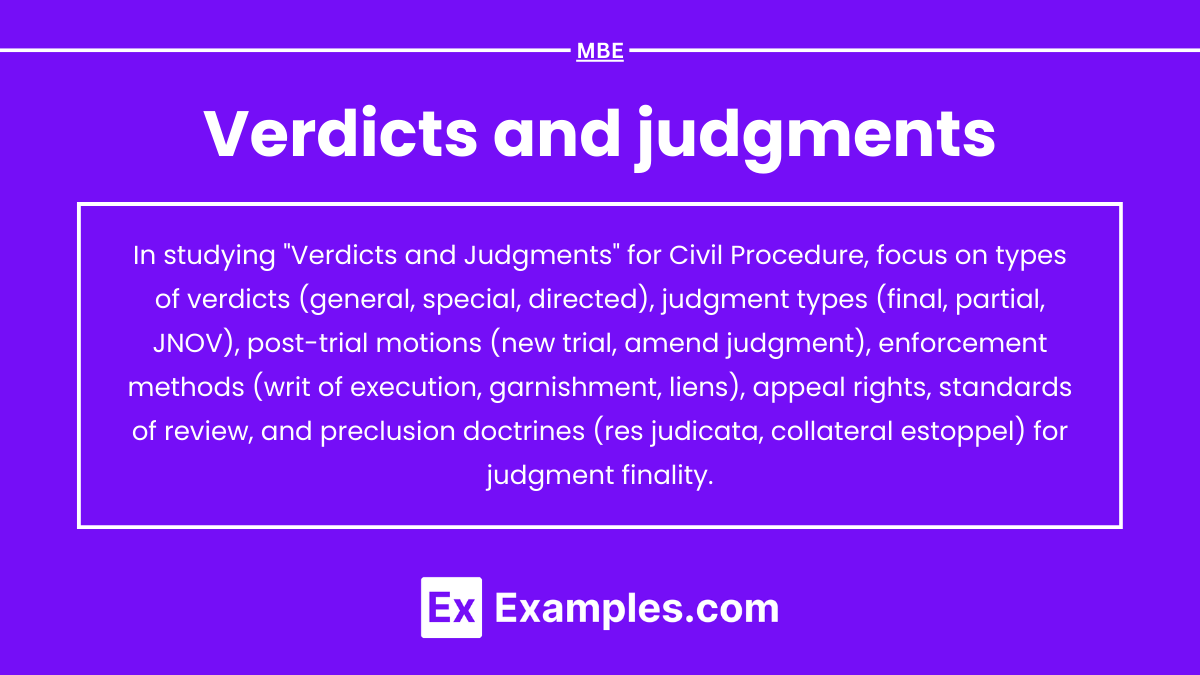In civil litigation, verdicts and judgments are crucial steps that mark the resolution of a case. A verdict, rendered by a jury or judge, determines the facts and assigns liability or exoneration. Following this, a judgment is issued by the court, formalizing the decision and establishing the parties' rights and obligations. This judgment can be enforced, modified, or appealed based on procedural rules and legal standards. Together, verdicts and judgments provide the legal conclusion and enforceable outcome of civil disputes.
Learning Objectives
In studying "Civil Procedure: Verdicts and Judgments" for the MBE, you should learn to understand the types of verdicts, including general, special, and directed verdicts, and how they are reached in civil trials. Analyze the processes involved in rendering judgments, such as judgment notwithstanding the verdict (JNOV), partial, and final judgments. Evaluate the principles behind post-trial motions like motions for a new trial or motions to amend a judgment. Additionally, explore enforcement mechanisms, including writs of execution and garnishments, and examine how appeals impact judgments. Apply your understanding to interpreting case scenarios that involve verdicts, judgments, and post-trial processes.
1. Verdicts
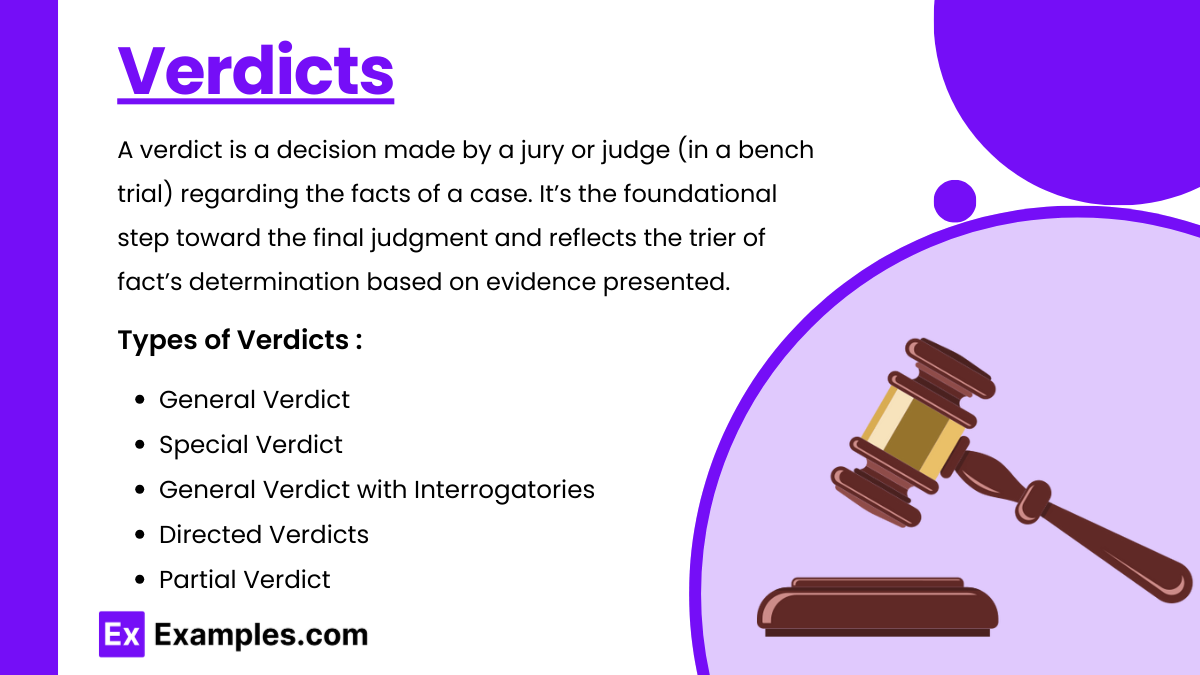
A verdict is a decision made by a jury or judge (in a bench trial) regarding the facts of a case. It’s the foundational step toward the final judgment and reflects the trier of fact’s determination based on evidence presented.
Types of Verdicts:
General Verdict: The jury issues a broad decision for either the plaintiff or defendant, specifying the amount of damages, if any. This is the most common type of verdict where the jury (or judge, in a bench trial) makes a definitive decision on the main issues in the case. It typically includes a determination of liability or guilt and may specify the amount of damages in civil cases.
Special Verdict: The jury answers specific factual questions, leaving the legal consequences to the judge, who then crafts a judgment based on those findings. In a special verdict, the jury answers specific factual questions without deciding the final outcome. The judge then applies the law to the jury’s findings to reach a final decision.
General Verdict with Interrogatories: A combination where the jury gives a general verdict but also provides answers to specific questions, which can clarify or justify their decision. This type combines a general verdict with specific questions (interrogatories) that the jury must answer regarding certain factual issues. The answers to the interrogatories must be consistent with the general verdict.
Directed Verdicts (Judgment as a Matter of Law):
This occurs when one party argues that no reasonable jury could find in favor of the other party based on the evidence presented.
A judge grants this only if the evidence overwhelmingly favors one side, leaving no factual dispute.
Timing: Usually moved for after the close of evidence but before the case goes to the jury.
Partial Verdict: In cases with multiple charges or claims, a jury may return a verdict on some but not all issues. For example, the jury might find a defendant guilty of one charge but be undecided on another.
2. Judgments
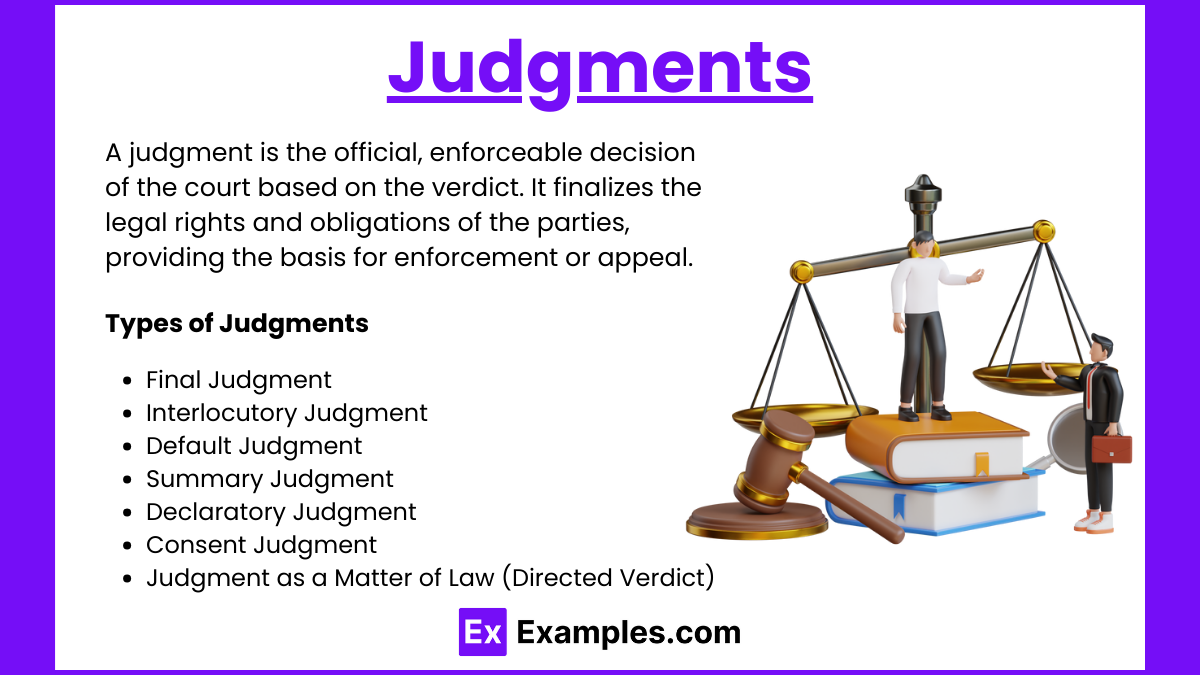
A judgment is the official, enforceable decision of the court based on the verdict. It finalizes the legal rights and obligations of the parties, providing the basis for enforcement or appeal.
Types of Judgments:
Final Judgment: Resolves all issues for all parties, making it appealable under the Final Judgment Rule.
Interlocutory Judgment: A non-final order issued during litigation, not resolving the entire case; typically not immediately appealable.
Default Judgment: Entered against a defendant who fails to respond or appear in court.
Summary Judgment: Granted when there is no genuine dispute of material fact, allowing the case (or issues within it) to be resolved without a trial.
Declaratory Judgment: Determines the rights or obligations of parties without ordering specific action or awarding damages.
Consent Judgment: Based on an agreement between parties, submitted for court approval and enforceable as a court order.
Judgment as a Matter of Law (Directed Verdict): Issued by a judge during a trial, concluding that no reasonable jury could find differently based on the evidence.
3. Post-Trial Motions Affecting Judgments
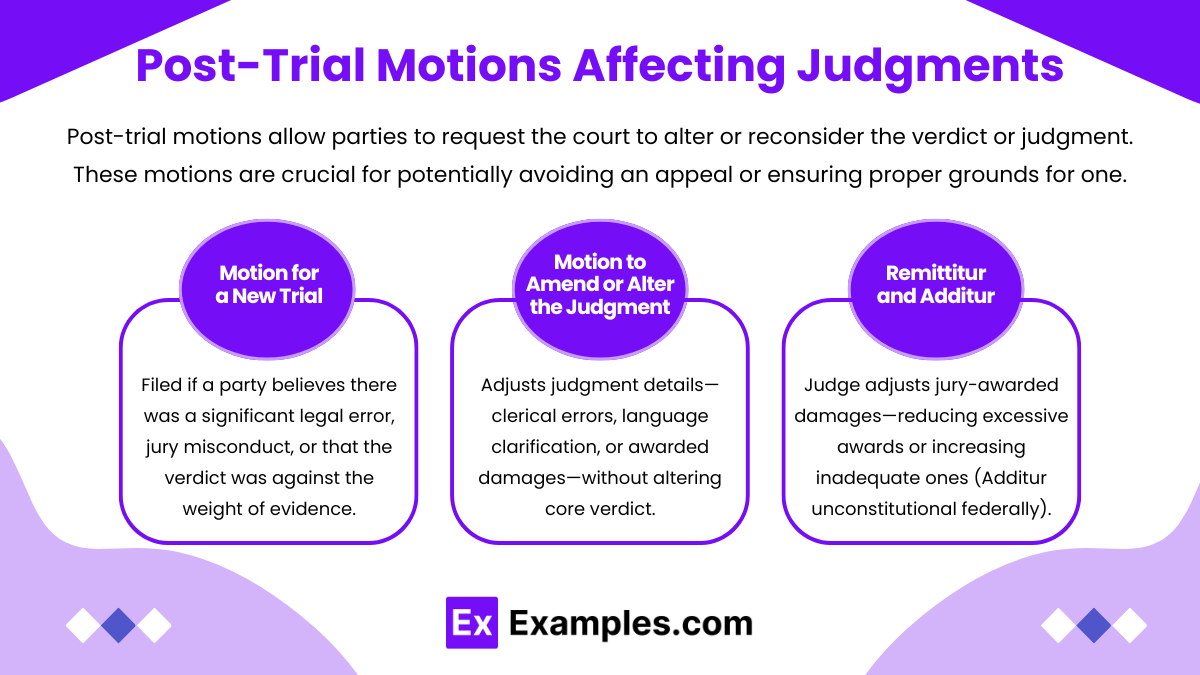
Post-trial motions allow parties to request the court to alter or reconsider the verdict or judgment. These motions are crucial for potentially avoiding an appeal or ensuring proper grounds for one.
Motion for a New Trial:
Filed if a party believes there was a significant legal error, jury misconduct, or that the verdict was against the weight of evidence.
The court has discretion to grant this and will typically do so if it finds a miscarriage of justice has occurred.
Motion to Amend or Alter the Judgment:
This motion can adjust certain aspects of a judgment without changing the core verdict.
Often used to correct clerical errors, clarify language, or adjust awarded damages.
Remittitur and Additur:
Remittitur: When the judge reduces the amount of damages awarded by the jury, typically because it’s deemed excessive.
Additur: When the judge increases the damages awarded, permissible only in some state courts (unconstitutional in federal court).
4. Enforcement of Judgments
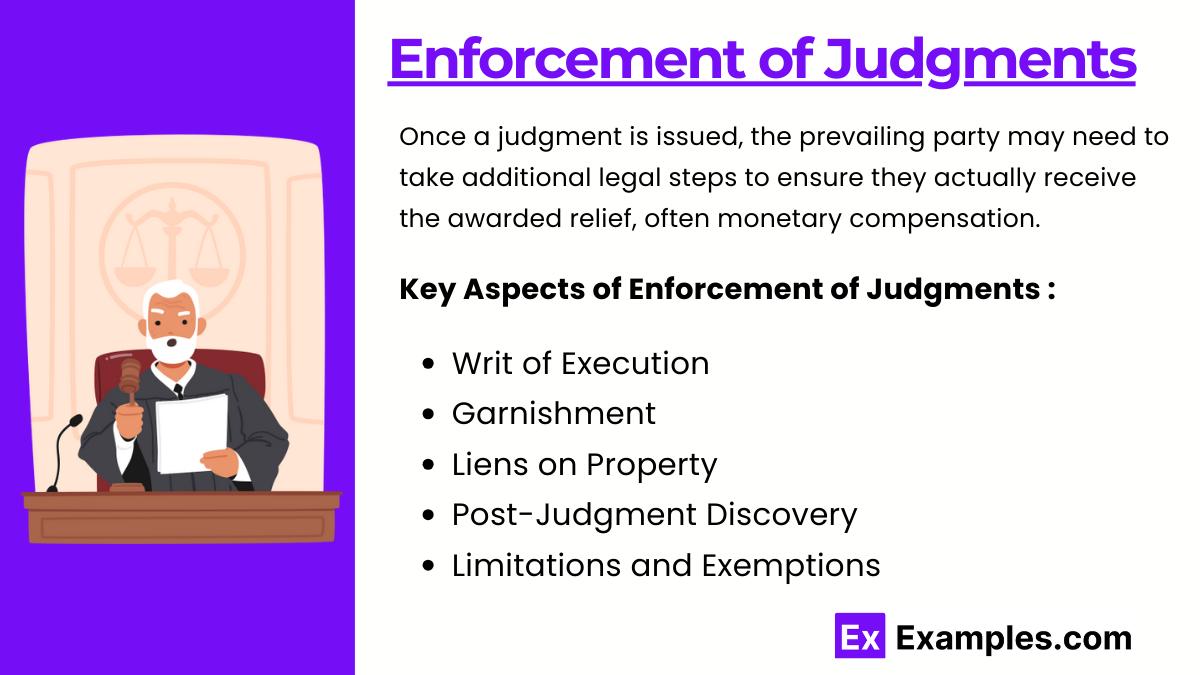
Once a judgment is issued, the prevailing party may need to take additional legal steps to ensure they actually receive the awarded relief, often monetary compensation. Enforcement refers to these steps, which can include garnishing wages, placing liens on property, or seizing assets to satisfy the judgment. Federal and state laws outline specific procedures and limitations on enforcement actions, ensuring due process and protecting certain debtor rights.
Key Aspects of Enforcement of Judgments:
Writ of Execution: This court order allows law enforcement to seize assets from the debtor to satisfy the judgment.
Garnishment: Wages, bank accounts, or other funds can be garnished to pay the judgment.
Liens on Property: A lien may be placed on the debtor’s real property, requiring payment upon sale or refinancing.
Post-Judgment Discovery: Allows the creditor to gather information about the debtor’s assets and income for enforcement purposes.
Limitations and Exemptions: Many states protect certain assets (e.g., primary residences, personal necessities) to limit undue hardship for debtors.
Examples
Example 1: General Verdict vs. Special Verdict
A jury finds in favor of the plaintiff, awarding $50,000 in damages. The judge then enters a general verdict, reflecting the jury’s broad decision for the plaintiff. However, in a separate case, the jury issues a special verdict by answering specific questions about facts (e.g., “Did the defendant act negligently?” “Did the plaintiff suffer injuries because of the defendant’s actions?”) without determining damages. The judge uses these answers to craft the final judgment. The distinction between these two verdict types is critical for MBE questions on jury roles and judicial discretion.
Example 2: Judgment Notwithstanding the Verdict (JNOV)
After a jury finds in favor of the plaintiff in a negligence case, the defendant moves for a Judgment Notwithstanding the Verdict (JNOV), arguing that no reasonable jury could have reached this decision based on the evidence presented. If the judge agrees and grants the JNOV, the judge effectively reverses the jury’s verdict, ruling in favor of the defendant. MBE questions often focus on when JNOV is appropriate, particularly in cases where the evidence clearly does not support the jury’s verdict.
Example 3: Directed Verdict
In a contract dispute, after the plaintiff presents their case, the defendant moves for a directed verdict (also known as Judgment as a Matter of Law in federal court), arguing that the plaintiff failed to provide sufficient evidence of a breach. The judge grants the motion, ending the trial in favor of the defendant before the jury even deliberates. This example is key for MBE questions examining the timing and requirements for directed verdicts, typically highlighting that directed verdicts are appropriate when there is no legally sufficient evidentiary basis for a reasonable jury to find otherwise.
Example 4: Remittitur and Additur
In a personal injury case, the jury awards 500,000 or risk a new trial. In another case, a jury awards damages that the judge finds insufficient. The judge proposes an additur to increase the award, though this is permitted in some state courts but generally unconstitutional in federal courts. MBE questions often test whether candidates understand the difference between remittitur and additur, as well as their availability in federal versus state systems.
Example 5: Motion for a New Trial Due to Jury Misconduct
After a jury finds in favor of the plaintiff in a defamation case, the defendant learns that a juror discussed the case with an outside party, violating court instructions. The defendant files a motion for a new trial based on jury misconduct, arguing that the misconduct affected the verdict. If the judge finds that the misconduct influenced the decision, they may grant the motion, ordering a new trial. MBE questions on this topic commonly address the grounds for a new trial, which can include jury misconduct, errors in law, or verdicts against the weight of evidence.
Practice Questions
Question 1
In a civil trial, the jury returns a verdict awarding the plaintiff 500,000 dollars in damages. The defendant believes that the evidence does not support this amount and that no reasonable jury could have found in the plaintiff’s favor. Which of the following is the defendant’s best option to challenge the jury’s verdict?
A. Motion for Summary Judgment
B. Motion for Directed Verdict
C. Motion for Judgment Notwithstanding the Verdict (JNOV)
D. Motion for New Trial
Answer: C. Motion for Judgment Notwithstanding the Verdict (JNOV)
Explanation: The correct answer is C. After a jury has returned a verdict, a party may file a Motion for Judgment Notwithstanding the Verdict (JNOV) (now often called a "Judgment as a Matter of Law" post-verdict in federal court). This motion argues that no reasonable jury could have reached the verdict based on the evidence presented. It allows the judge to override the jury’s decision if the evidence overwhelmingly supports the moving party. A JNOV motion is only available after the verdict is returned, whereas a Motion for Directed Verdict (B) is made before the jury deliberates.A. A Motion for Summary Judgment is typically filed before the trial begins when a party believes there are no genuine disputes of material fact, making it inapplicable at this stage. B. A Motion for Directed Verdict is also made before the jury begins deliberations. D. A Motion for New Trial allows for a trial redo due to significant legal errors or issues in the trial, but it does not challenge the jury’s verdict in the same way that a JNOV does.
Question 2
A judge grants the plaintiff’s motion for summary judgment on one claim in a case involving multiple claims. The other claims are set for trial. What is the nature of the judgment on this single claim?
A. Partial Judgment
B. Final Judgment
C. Declaratory Judgment
D. Interlocutory Judgment
Answer: A. Partial Judgment
Explanation: The correct answer is A. A Partial Judgment addresses one or more but not all claims or parties within a case. It allows for specific claims to be resolved while others continue toward trial. Here, summary judgment on one claim resolves that particular issue but leaves the other claims for future litigation, making it a partial rather than a final judgment. B. A Final Judgment resolves all claims and issues, ending the case entirely, so this would not apply here since other claims remain. C. A Declaratory Judgment merely declares the rights of the parties without enforcing any specific relief. D. An Interlocutory Judgment is a temporary order issued before a final judgment but does not generally resolve claims.

